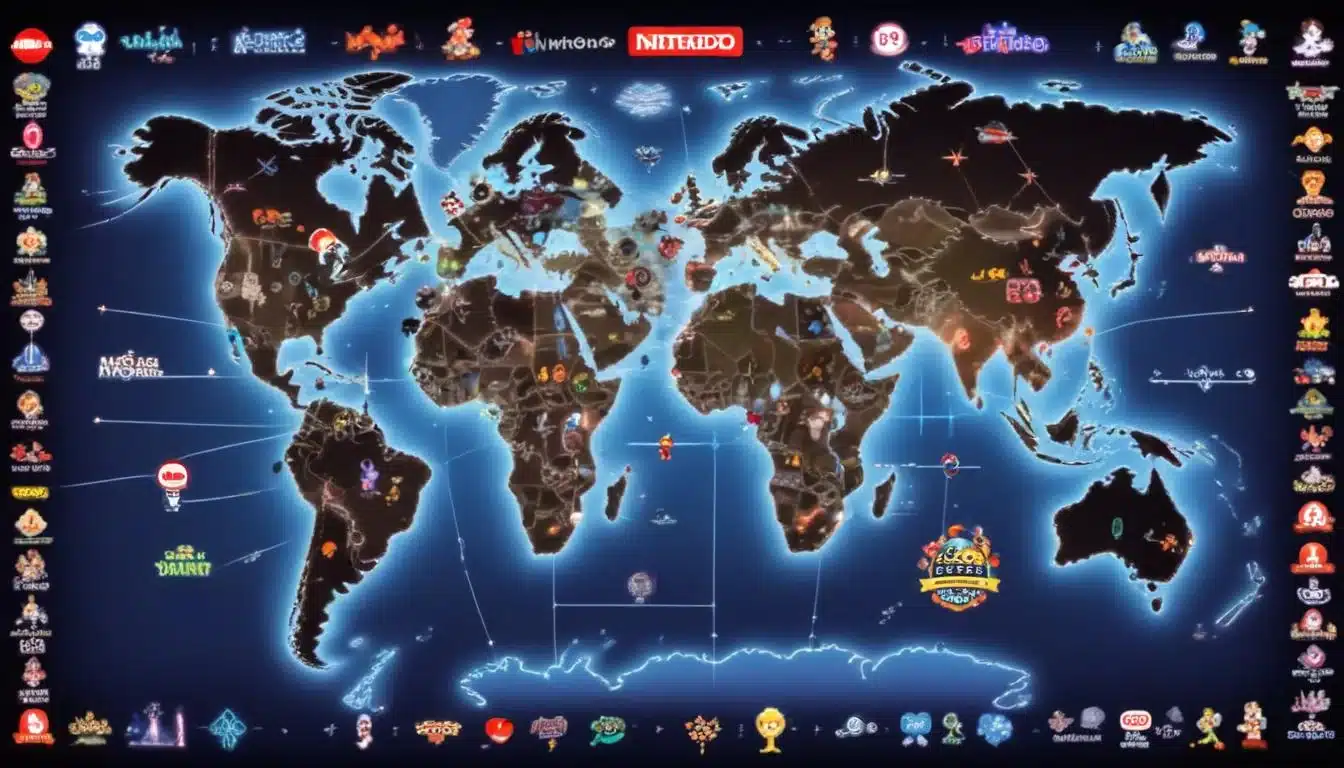Nintendo’s 2025 Strategy: Financial Report Analysis

Nintendo’s 2025 strategy, derived from its latest financial report, emphasizes continued innovation in hardware and software, leveraging strong intellectual properties, and expanding its global digital presence for sustained growth.
As the gaming landscape rapidly evolves, understanding Nintendo’s Strategy for 2025: Analyzing the Company’s Latest Financial Report becomes paramount for enthusiasts and investors alike. This deep dive will unravel the intricacies of Nintendo’s financial health and strategic pivots, offering a clear vision of its future trajectory.
Decoding the Latest Financial Report: A Snapshot of Nintendo’s Health
Nintendo’s recent financial report provides a critical lens through which to view its current standing and future ambitions. This document is far more than just numbers; it’s a narrative of success, challenges, and calculated risks. By meticulously examining key financial indicators, we can discern the underlying health of the company and the effectiveness of its ongoing strategies.
The report highlights several crucial areas, including revenue generation, profit margins, and research and development investments. A strong performance in these metrics often signals a company’s capacity for innovation and its ability to weather market fluctuations. Nintendo’s unique position in the industry, blending hardware and software development, means its financial health is intrinsically linked to both console sales and game releases.
Revenue streams and profitability
Nintendo’s revenue primarily stems from three major segments: dedicated video game platforms (hardware and software), mobile and IP related income, and playing cards. The dedicated video game platform segment consistently leads, driven by strong console sales and blockbuster game titles. Profitability, while robust, is subject to the cyclical nature of console generations and the highly competitive gaming market.
- Hardware Sales: Continues to be a significant contributor, with the Switch console demonstrating remarkable longevity.
- Software Sales: Driven by first-party titles, which consistently rank among the best-selling games globally.
- Digital Revenue: Growing steadily through eShop purchases, subscriptions like Nintendo Switch Online, and DLC.
Understanding these revenue streams is essential for appreciating the breadth of Nintendo’s business model. The balance between physical and digital sales, coupled with the recurring revenue from online services, paints a picture of a company adapting to modern consumer habits while maintaining its core strengths.
The latest report indicates a healthy balance sheet, with substantial cash reserves that provide a buffer against economic downturns and enable strategic investments. This financial stability is a cornerstone of Nintendo’s ability to pursue long-term projects and maintain its independence in a rapidly consolidating industry. The company’s commitment to sustainable growth is evident in its cautious yet innovative approach to market expansion.
Innovation in Hardware: What’s Next for Nintendo Consoles?
The gaming world is always abuzz with speculation about Nintendo’s next hardware iteration, and the financial report often drops subtle hints. While direct announcements are rare in these documents, investment in research and development (R&D) and projected capital expenditures can illuminate the path forward. Nintendo’s history is defined by its willingness to innovate, often choosing unique gameplay experiences over raw power.
The success of the Nintendo Switch has demonstrated the viability of hybrid gaming, blurring the lines between home console and portable device. The question for 2025 is not just about a successor, but how Nintendo plans to evolve this successful formula. Will it be a more powerful iteration, a completely new concept, or a refinement of the existing hybrid model?
Research and development investments
The financial statements reveal significant and sustained investment in R&D, a clear indicator that Nintendo is actively exploring new technologies and concepts. These investments are crucial for developing not only new hardware but also the innovative software that defines Nintendo’s appeal. This forward-looking approach is a hallmark of their strategy.
- Next-generation hardware: Although unconfirmed, R&D spending suggests ongoing development for future console technologies.
- Enhanced user experiences: Focus on new ways to interact with games, potentially leveraging new input methods or display technologies.
- Sustainable manufacturing: Investments in eco-friendly production processes and materials.
The financial report also touches upon supply chain management and component procurement, which are critical for any hardware manufacturer. Ensuring a stable supply of components, especially in a volatile global market, is a key strategic consideration. This forward planning ensures that when new hardware is ready, it can be produced and distributed effectively to meet consumer demand.

Game Development and IP Leverage: The Heart of Nintendo’s Appeal
At the core of Nintendo’s enduring success lies its unparalleled library of intellectual properties (IPs) and its commitment to innovative game development. The financial report often provides insights into the strategic allocation of resources towards these critical areas. Strong first-party titles are not just revenue generators; they are ecosystem drivers, compelling consumers to purchase Nintendo hardware.
For 2025, the strategy appears to be a dual approach: nurturing existing beloved franchises while simultaneously fostering new, experimental titles. This balance is crucial for maintaining relevance and attracting new players without alienating the loyal fanbase. The report details sales figures for various game categories, offering a glimpse into which genres and franchises are performing strongest.
Strategic investment in first-party titles
Nintendo’s financial documents consistently show a significant portion of their budget dedicated to internal game development. This ensures a steady pipeline of high-quality, exclusive content that differentiates Nintendo from its competitors. The emphasis on unique gameplay mechanics and polished experiences is a cornerstone of their development philosophy.
- Expansion of existing franchises: New entries in popular series like Mario, Zelda, and Pokémon continue to drive sales.
- Development of new IPs: Investment in fresh concepts and experimental games to broaden appeal.
- Third-party partnerships: Collaborations with other developers to bring diverse content to Nintendo platforms.
Beyond traditional console games, Nintendo’s strategy for 2025 also includes leveraging its IPs across various media. This includes animated films, merchandise, and theme park attractions, all of which contribute to brand visibility and revenue. The financial report often provides a breakdown of income from these ancillary sources, demonstrating the broad reach of Nintendo’s characters.
The report also touches upon the long-term engagement of players through downloadable content (DLC), online services, and community events. These initiatives not only generate additional revenue but also strengthen the bond between players and Nintendo’s ecosystem, fostering a loyal and active community around its games.
Expanding Digital Services and Online Presence
The digital frontier represents a significant growth area for Nintendo, and their 2025 strategy, as outlined in the financial report, places a strong emphasis on expanding digital services and enhancing their online presence. This includes everything from the Nintendo eShop to the Nintendo Switch Online subscription service, and even broader digital initiatives.
The shift towards digital distribution offers numerous advantages, including reduced manufacturing and distribution costs, direct customer engagement, and the potential for recurring revenue streams. Nintendo is keen to capitalize on these benefits while still supporting physical game sales, offering consumers choice.
Growth of Nintendo Switch Online
The Nintendo Switch Online service has become a cornerstone of Nintendo’s digital strategy, offering online multiplayer, a library of classic games, and cloud saves. The financial report often details subscriber growth and engagement metrics, indicating the success of this service. For 2025, expect further enhancements and expansions to its offerings.
- Increased subscriber base: Continuous growth driven by new game releases and service improvements.
- Expansion Pack tiers: Additional content and classic console libraries to enhance value.
- Exclusive member benefits: Special offers, games, and content for subscribers.
Beyond the subscription service, Nintendo is also investing in its digital infrastructure to ensure a seamless and secure online experience for players. This includes improvements to the eShop, enhanced security measures, and better integration of online features within games. The report often highlights these infrastructure investments as key to supporting their digital growth.
Furthermore, the financial report indicates a strategic focus on data analytics to better understand player behavior and preferences. This data-driven approach allows Nintendo to tailor its digital offerings, personalize experiences, and optimize marketing efforts, ultimately driving greater engagement and revenue from its online ecosystem.
Global Market Penetration and Regional Strategies
Nintendo’s global reach is undeniable, but its financial report often reveals nuanced regional strategies tailored to specific market conditions. For 2025, the company aims to deepen its penetration in established markets while also exploring growth opportunities in emerging economies. This involves understanding diverse consumer preferences, cultural nuances, and economic factors.
The report typically breaks down sales and revenue by geographical region, offering valuable insights into where Nintendo is performing strongest and where there are opportunities for expansion. This granular data informs their localization efforts, marketing campaigns, and even game development priorities.
Targeting key demographics
Nintendo’s appeal spans a wide demographic, from young children to older adults, and its strategy for 2025 involves targeted marketing to maintain this broad appeal. The financial report may hint at investments in specific advertising channels or partnerships aimed at reaching particular segments of the population.
- Family-friendly content: Continued focus on games suitable for all ages, a Nintendo hallmark.
- Esports initiatives: Exploring competitive gaming opportunities for select titles to engage a dedicated audience.
- Educational and wellness applications: Potential expansion into new software categories that align with Nintendo’s brand values.

The financial report also emphasizes the importance of strong local partnerships for distribution, marketing, and customer support. These collaborations are crucial for navigating the complexities of international markets and ensuring that Nintendo’s products and services are accessible to a global audience. The focus on regional autonomy within a global framework allows for agile responses to local market demands.
Moreover, the report highlights Nintendo’s commitment to cultural sensitivity and localization in its game development and marketing. This approach ensures that their products resonate with diverse audiences worldwide, fostering a sense of connection and enjoyment regardless of geographical location.
Challenges and Opportunities: Navigating the Future Landscape
No financial report is complete without acknowledging the challenges and opportunities that lie ahead. For Nintendo, 2025 presents a dynamic landscape characterized by intense competition, technological advancements, and evolving consumer expectations. The report often outlines how the company plans to mitigate risks and capitalize on emerging trends.
Competition from other console manufacturers, PC gaming, and mobile platforms remains a significant factor. Nintendo’s strategy must continually adapt to these external pressures while staying true to its core identity. The rapid pace of technological change also presents both challenges and opportunities for hardware and software innovation.
Addressing market competition
Nintendo’s unique value proposition, centered on innovative gameplay and strong first-party IPs, serves as its primary defense against market competition. However, the financial report may suggest further strategic moves, such as exclusive content deals or competitive pricing strategies, to maintain its market share.
- Differentiated hardware: Continuing to offer unique gaming experiences not found on other platforms.
- Exclusive software lineup: Leveraging beloved franchises to drive console sales.
- Strong community engagement: Building a loyal fanbase through online services and events.
The report also details Nintendo’s approach to sustainability and corporate social responsibility (CSR). These initiatives, while not directly financial, contribute to brand reputation and long-term viability, appealing to an increasingly socially conscious consumer base. Investments in eco-friendly practices and ethical supply chains are becoming more prominent in their strategic outlook.
Looking ahead, the opportunity for Nintendo lies in its ability to continue surprising and delighting players with innovative experiences. The financial report underscores a company that is financially sound, strategically focused, and poised to navigate the complexities of the modern gaming industry with confidence and creativity. Their commitment to fun and innovation remains their greatest asset in a competitive world.
| Key Strategic Area | Brief Description |
|---|---|
| Hardware Innovation | Continued investment in R&D for next-gen consoles, focusing on unique gameplay experiences. |
| IP & Game Development | Nurturing existing franchises and fostering new IPs for a robust exclusive software lineup. |
| Digital Expansion | Growing Nintendo Switch Online and enhancing eShop services for recurring revenue. |
| Global Market Strategy | Deepening penetration in established markets and exploring growth in emerging regions. |
Frequently Asked Questions About Nintendo’s 2025 Strategy
The financial report highlights significant R&D investments, suggesting active development for next-generation hardware. While specifics are not disclosed, it indicates a continued focus on innovation and unique gaming experiences, building on the success of the hybrid model.
Nintendo is leveraging its IPs by developing new entries in popular franchises, fostering new game concepts, and expanding into other media like films and theme park attractions. This multi-faceted approach maximizes brand reach and revenue.
Digital services are crucial, with a strong focus on growing Nintendo Switch Online subscribers and enhancing the eShop. This includes expanding classic game libraries, offering exclusive member benefits, and improving overall digital infrastructure for a seamless user experience.
Nintendo is pursuing a strategy of deepening penetration in established markets while exploring emerging economies. This involves tailoring regional approaches, understanding local preferences, and forming strong partnerships for distribution and marketing to ensure global accessibility.
Nintendo faces challenges from intense market competition and rapid technological advancements. Opportunities lie in continued hardware and software innovation, leveraging its unique IPs, and expanding digital services to maintain its distinct position in the competitive gaming industry.
Conclusion
Nintendo’s Strategy for 2025: Analyzing the Company’s Latest Financial Report reveals a robust and forward-thinking organization. The company remains committed to its core principles of innovation in hardware and software, leveraging its iconic intellectual properties, and strategically expanding its digital footprint. With a healthy financial outlook and a clear vision for global market penetration, Nintendo is well-positioned to navigate the evolving gaming landscape, continuing to deliver unique and engaging experiences to players worldwide while adapting to new challenges and seizing emerging opportunities in the years to come.